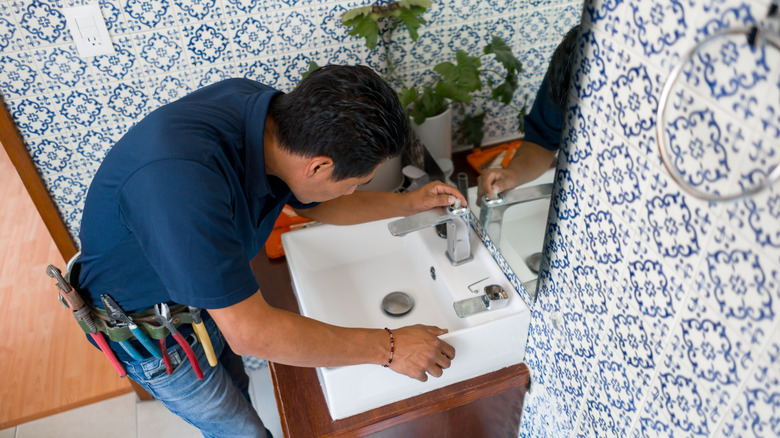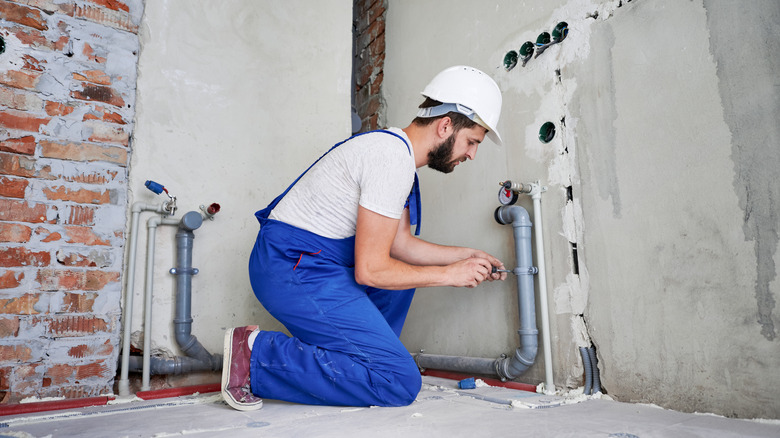Things To Consider Before Adding A Bathroom To Your Basement, According To Our Home Reno Expert
Adding a bathroom to your basement has a ton of perks. First, it's super convenient. Whether you're a family of two or five, it's always advantageous to have an extra toilet or shower on hand. That way, you don't have to pound on the door because you're running late for work or are having a bathroom emergency. Second, it also boosts the market value of your property. According to real estate experts polled for a 2024 report at Remodeling Magazine, you get a potential ROI of 34.7%. That means for every $1,000 you spend, you can expect to get back just under $350. But before you start asking for contractor bids to start this project, there are some things you should consider before adding a bathroom to your basement. Since it's a complicated and rather expensive job, House Digest exclusively asked Jeff Thorman, host of Home RenoVision DIY, what to weigh before taking the plunge.
The first consideration is how easy it will be to either move or freshly install plumbing in the basement. Since you're working with a concrete foundation, it can become pretty difficult (and pricey) to either rough in plumbing or move existing pipes to better suit your intended layout. These expenses can add up rapidly, so you'll want to ensure your job isn't too complicated. The second consideration is whether your vent pipe can handle an extra bathroom. Let's take a closer look at what to weigh before adding a bathroom to your finished basement.
Consider how easy it will be to move plumbing
If you have a finished basement, the builder probably installed some rough in plumbing before closing up the walls with drywall. If so, Thorman points out that it will limit your design options since you already have your pipe placement. "The only consideration is the limitations to the bathroom layout based on the existing plumbing locations," he exclusively tells House Digest. "If you need to break the concrete to move plumbing, you are looking at a pricier renovation." Because of this, he recommends not getting too fancy with the layout and using the existing plumbing locations.
You also want to be very precise about your final plan. Making the wrong measurements and ordering toilets that are too large or shower floors with differently located drainage holes can lead to a pricy fix. That's because you have to re-open the concrete to get to the pipes and move them if you make a mistake in the layout, which is a major project. Because of this, people often try to find workarounds instead of bringing out the jackhammer. Thorman used the example of accidentally installing a new toilet too close to the finished wall. "Instead of opening the concrete to adjust, a common fix for this is to buy a toilet with a 10-inch clearance from the wall to the center of the drain pipe versus the 12-inch standard," he explains.
Consider whether your vent pipe can handle an extra bathroom
The vent pipe in your plumbing system plays a crucial role in your home. It allows air to enter the house's drainage pipe, which moves the water and waste along. Without it, a vacuum will be created, stopping the sewage in its tracks. As you can imagine, this spells disaster. "Not having enough ventilation creates a vacuum effect in your drain system, which impedes the flow of effluent and can cause sewer backups. It also pulls the water out of the P-traps and allows sewer gas to enter into the basement. This is not only unpleasant but potentially can carry methane, which is explosive," Thorman exclusively tells House Digest. Because of this, you must first ensure that your vent pipe can handle an extra toilet.
If it can't, you can upgrade your plumbing to accommodate it. "You will want to make sure your venting solution is up to your local building code," Thorman warns. This isn't a DIY project you can tackle alone; instead, you will need to hire a professional plumber. Most likely, the solution will be that you will need to install a new vent pipe and exhaust fan, which will need to run outside of an exterior wall. Depending on where you live and who you hire, this project typically runs anywhere from $900 to $3,000.


